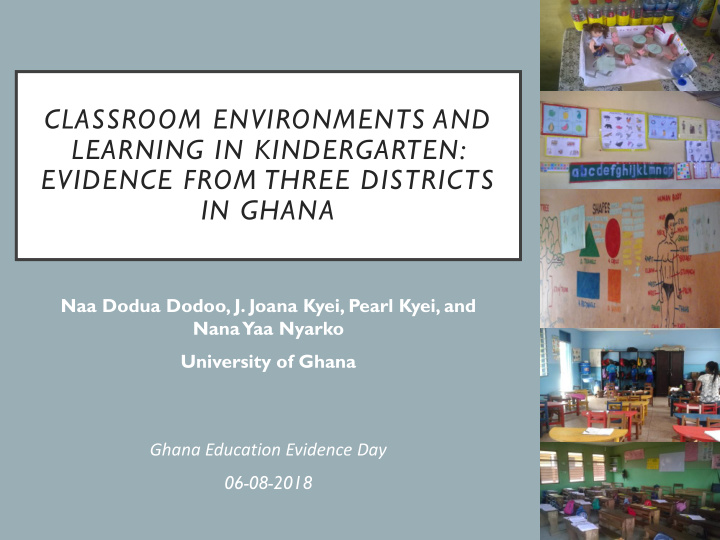



CLASSROOM ENVIRONMENTS AND LEARNING IN KINDERGARTEN: EVIDENCE FROM THREE DISTRICTS IN GHANA Naa Dodua Dodoo, J. Joana Kyei, Pearl Kyei, and Nana Yaa Nyarko University of Ghana Ghana Education Evidence Day 06-08-2018
OUTLINE • Key findings • Policy Issue • Study Design • Results • Conclusions and policy lessons
KEY FINDINGS • Basic schools need instructional space to accommodate kindergarten classrooms • The physical environment of KG classrooms must be upgraded to be more conducive for learning • The spacing in KG classrooms needs to be improved to encourage child-centred learning • Kindergarten teachers need support • Having attendants and teaching assistants makes teachers more effective • Pre-service and in-service training in early childhood development and care makes teachers more effective
POLICY ISSUE • “Investing in the early years is one of the smartest things a country can do to eliminate extreme poverty, boost shared prosperity, and create the human capital needed for economies to diversify and grow.” • UNICEF • “Evidence that an additional dollar invested in quality early childhood programs yields a return of between $6 dollars and $17 dollars.” • World Bank
RESEARCH QUESTIONS • How conducive is the classroom environment for learning in early grades? • Outcomes: classroom learning environment (teaching and learning materials, structural quality, sensory distractions and instructional support) • How does the classroom environment influence student performance? • Outcomes: Pupil performance (literacy, numeracy and reasoning
SURVEY DATA • Ethical clearance for the research was obtained from the University of Ghana Ethics Committee for Humanities • Approval to conduct research in basic schools was obtained from the GES National and District offices • Fieldwork was conducted in May-June 2016
KEY FINDINGS Majority of KG 100 classrooms had teaching and 80 learning materials 60 However TLMs 40 were not always accessible to 20 pupils 0 Visual aids Toys Books ICT Musical Instruments KG1 KG2
KEY FINDINGS 100 Kindergarten 80 classrooms were of lower 60 structural quality than P1 40 classrooms 20 0 Enclosed Completed Cluttered Space for Exit safe in space structure pupil emergency movement KG1 KG2 P1
KEY FINDINGS 100 90 KG classrooms were 80 more likely to be 70 located where there 60 were sensory distractions compared 50 to P1 classrooms. 40 30 20 10 0 Seating appears Lighting to see all External noise Unpleasant Classroom comfortable relevant materials audible in odours from temperature classroom outside smelt in uncomfortable classroom KG1 KG2 P1
KEY FINDINGS Teacher Characteristics About a third of 100 teachers were 80 not comfortable teaching at this 60 level 40 Linked to them 20 not having had 0 ECD training or Pre-service Has a teaching Prefers to be Comfortable having teaching ECD training assistant teaching at teaching assistants another level children this young KG1 KG2
KEY FINDINGS 55% correct 87% correct Pupils performed worse on reasoning type 73% correct questions
KEY INFLUENCES ON PERFORMANCE KG1 KG2 • non-ECD teacher • layout and design (+), training (-) • learning materials (+), • class size (-) • teacher experience (+) • teacher comfort level with grade (+), • Language spoken at home and language of instruction match (+)
POLICY RECOMMENDATIONS 1. Improve spacing in early grade classrooms 2. Improve physical environment in kindergarten classrooms 3. Support teachers by providing teaching assistants 4. Provide consistent in-service training on early childhood to equip early grade teachers with the requisite skills.
DISSEMINATION EVENTS • Takeaways from district dissemination events: • Study findings were in line with anecdotal evidence of practitioners • Dissemination should also be done at the national level • Teaching assistants and attendants are needed but there are limited resources at the district and school level to pay for them • Assemblies continue to build 6-unit classroom block instead of 8-unit blocks that can accommodate kindergarten and primary
ACKNOWLEDGEMENTS • International Growth Centre (IGC) • Ghana Education Service Basic Education Division • Adentan Municipal Education Directorate • Awutu Senya East Municipal Education Directorate • Ga East Municipal Education Directorate • Shai Osudoku District Education Directorate
THANK YOU FOR YOUR ATTENTION Questions or comments? Email: pkyei@ug.edu.gh ndodoo@ug.edu.gh ynyarko@ug.edu.gh
Recommend
More recommend